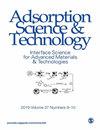Remediation of Azure A Dye from Aqueous Solution by Using Surface-Modified Coal Fly Ash Extracted Ferrospheres by Mineral Acids and Toxicity Assessment
IF 2.8
4区 工程技术
Q2 CHEMISTRY, APPLIED
引用次数: 10
Abstract
The Indian coal fly ash (CFA) is composed of 5-15% ferrous fractions. The variation in percentage depends on the source of coal and the operating conditions of the thermal power plants. The present research work reports the recovery of ferrous particles from CFA by the wet magnetic separation method. The morphological, elemental, and chemical properties of the extracted ferrous fractions were analyzed. In order to achieve surface-modified ferrospheres, the extracted ferrospheres were treated with concentrated HCl followed by sonication. The instrumental analysis reported the ferrous composition is around 16% by weight and belongs to class F. The toxicity of CFA was determined on normal human lung (BEAS-2B) cells using MTS assay. The results showed that CFA’s induced cell toxicity in a dose-dependent manner. The ferrous particles were spherically shaped with various sizes ranging from 200 nm to 7000 nm. It was crystalline in nature and is a mixture of hematite and magnetite. The particles were found to be associated with alumina, silica, oxygen, and traces of Ca, Mg, Ti, and C. The surface-modified ferrospheres were used for the remediation of Azure A dye by batch adsorption study. The removal percentage of dye was 25.03%, within 30 minutes at neutral pH, i.e., 7.2. The surface-modified ferrospheres show potential as an alternate, more economical, and reusable adsorbent for the remediation of Azure A dye in the industries or in common effluent treatment plants. Moreover, the recovery of surface-modified ferrospheres using an external magnet and the reuse of the particles make the material much economical for dye removal at an industrial scale.表面改性粉煤灰矿物酸萃取铁球对水溶液中Azure A染料的修复及毒性评价
印度粉煤灰(CFA)由5-15%的含铁部分组成。百分比的变化取决于煤的来源和火力发电厂的运行条件。本研究报告了用湿式磁选法从CFA中回收含铁颗粒。对提取的含铁组分的形态、元素和化学性质进行了分析。为了获得表面改性的铁球体,提取的铁球体用浓HCl处理,然后进行超声处理。仪器分析报告,含铁成分约为16%(重量),属于F类。使用MTS测定法测定CFA对正常人肺(BEAS-2B)细胞的毒性。结果表明,CFA诱导细胞毒性呈剂量依赖性。含铁颗粒呈球形,各种尺寸从200 nm至7000 nm。它本质上是结晶的,是赤铁矿和磁铁矿的混合物。发现颗粒与氧化铝、二氧化硅、氧气和微量Ca、Mg、Ti和C缔合。通过分批吸附研究,表面改性的铁球用于修复Azure A染料。在中性pH即7.2下,30分钟内染料的去除率为25.03%。表面改性的铁球体显示出作为替代、更经济和可重复使用的吸附剂的潜力,可用于工业或常见污水处理厂中的Azure A染料的修复。此外,使用外部磁体回收表面改性的铁球体和颗粒的再利用使该材料在工业规模上非常经济地去除染料。
本文章由计算机程序翻译,如有差异,请以英文原文为准。
求助全文
约1分钟内获得全文
求助全文
来源期刊

Adsorption Science & Technology
工程技术-工程:化工
CiteScore
5.00
自引率
10.30%
发文量
181
审稿时长
4.5 months
期刊介绍:
Adsorption Science & Technology is a peer-reviewed, open access journal devoted to studies of adsorption and desorption phenomena, which publishes original research papers and critical review articles, with occasional special issues relating to particular topics and symposia.
 求助内容:
求助内容: 应助结果提醒方式:
应助结果提醒方式:


